There are six heat sources for cooking outdoors: Hardwood logs, hardwood pellets, hardwood lump charcoal, charcoal briquets, gas, and electric. Each produces a different flavor, and each has its strengths and weaknesses.
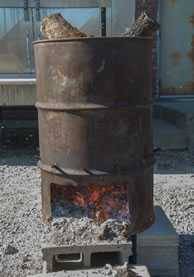
1) Hardwood logs are the way it all started. Cooking with logs is tricky and requires the right kind of cooker, the right kind of wood, and lots of practice. Controlling temperature is tricky. For grilling they are especially problematic since wood flares up a lot and burns very hot. Most stick burners, as they like to call themselves, start the wood burning outside the cooker, let it burn down to glowing embers, and then they cook with the embers. At right is a classic “burn box” made from a 55 gallon drum for preparing embers. If you don’t get it right, you’ll waste a lot of food. It is easy to burn your meal and easier to make it taste like an ashtray full of cigarette butts. Most backyard cooking devices cannot burn logs. But there are some big rigs that do. You never want to burn softwood or resinous wood like pine because the sap burns very hot and the flavors are not very tasty. Some are hazardous. I do not recommend burning logs unless you are an experienced pitmaster.
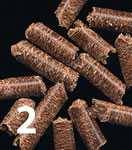
2) Hardwood pellets, on the other hand hardwood pellets are about the easiest method going. The newfangled cookers that use them are modern marvels with digital thermostat controllers. Pellets are sawdust that is compressed into little rabbit pellet sized chunks no thicker than a pencil each less than 1/2″ long. The pellets are fed into a burn pot and ignited. The number of pellets and the oxygen supply are regulated by a digital controller. Some of the better controllers are accurate to within 5°F, and that’s more accurate than most indoor ovens. The better pellet burners are literally “set it and forget it”. They are best at indirect heat smoking since most do not do direct heat grilling at all, and the few that do, don’t do it well. I have never seen one that gives a proper sear to a steak. Almost all of them are designed so there is a metal plate between the burn box and the food, so they are indirect cookers out the door of the factory, like an indoor oven. But when it comes to smoking, they are superlative. And the food tastes beautiful, although some owners complain that it is not as smoky as they like it. On the down side, they give everything a smoke flavor, and sometimes you just don’t want it. As counterintuitive as this seems, the subtle smoke flavor is because the wood combusts so thoroughly and efficiently. Click here for more about pellet grills and smokers as well as a buyer’s guide.
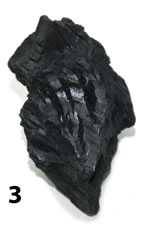
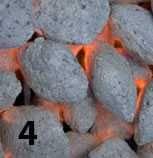
3) Lump charcoal or (4) charcoal briquets. Charcoal is made by an ancient process of partially burning hardwood until it carbonizes forming char, which is a highly efficient fuel source. Charcoal can burn practically smokeless, but it usually produces flavorful smoke, and it is capable of very high searing temps. It is especially good for steaks. It takes longer to get up to cooking temp than gas or pellets, and there is ash to be disposed of so setup and cleanup are slightly more labor intensive than otehr fuels. I highly recommend charcoal, especially in combination with smoke producing hardwood chips, chunks, and pellets. There are two basic types of charcoal, lump or briquets. To learn more about the production process of both briquets and lump, read my article on the Science of Charcoal. Click here for a buyers guide to charcoal grills, and here for a buyer’s guide to charcoal smokers. Click here for an article on setting up a charcoal grill.
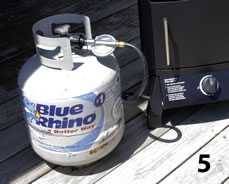
5) Gas comes in two forms, bottles of liquid propane, and piped in natural gas. The flavor is identical. Gas grills and smokers are extremely easy to use and produce good flavor, especially when combined with hardwood chips, chunks, or pellets. Gas grills are the most popular because they fire right up and require little cleanup. For more about how gas grills work, their strengths and weaknesses, read my article on gas grill setup. Click here for our overview of gas grills, and here for our take on gas smokers.

6) Electric grills and smokers use a heating element that glows as electricity passes through it, sort of like a giant light bulb. The glowing element generates heat that cooks the meat. Because there is no burning, there is no cellulose, lignin, char, or even oxygen combusted, there are no combustion gases. There is no smoke, and so there is no smoke flavor. The great advantage is that electric heat is very easy to control, and because there is no fire, it is allowed on most apartment balconies that forbid other grills. You can use sawdust and wood chips with some electric grills, and get a nice smoke flavor, but it is different from other smoke flavors because the wood smolders at a low temp. Electric smokers can make smoke from wood, but the burn temp is so low that the flavor is very different than gas or charcoal smokers, and in my mind, inferior for most foods. Nor do electric grills get hot enough to properly sear a steak without overcooking the interior, and most cannot be configured in a 2-zone setup. I recommend electric grills and smokers only for people in buildings where gas and charcoal are not allowed.
Other buying guides
- Grills & Smokers
- Thermometers
- Barbecue accessories
- Barbecue wood
- Barbecue sauces
- Kitchen tools
- Grill grates & surfaces
- Grill grate brushes and cleaners
- Injectors
- Cookbooks, books, and magazines
- Grill parts
- Steak knives
- Aprons, hats, and tschotschkes
- Bar necessities
- Corkscrews
- Photo equipment
- Music and tunes about food
- Extension cords



High quality websites are expensive to run. If you help us, we’ll pay you back bigtime with an ad-free experience and a lot of freebies!
Millions come to AmazingRibs.com every month for high quality tested recipes, tips on technique, science, mythbusting, product reviews, and inspiration. But it is expensive to run a website with more than 2,000 pages and we don’t have a big corporate partner to subsidize us.
Our most important source of sustenance is people who join our Pitmaster Club. But please don’t think of it as a donation. Members get MANY great benefits. We block all third-party ads, we give members free ebooks, magazines, interviews, webinars, more recipes, a monthly sweepstakes with prizes worth up to $2,000, discounts on products, and best of all a community of like-minded cooks free of flame wars. Click below to see all the benefits, take a free 30 day trial, and help keep this site alive.
Post comments and questions below
1) Please try the search box at the top of every page before you ask for help.
2) Try to post your question to the appropriate page.
3) Tell us everything we need to know to help such as the type of cooker and thermometer. Dial thermometers are often off by as much as 50°F so if you are not using a good digital thermometer we probably can’t help you with time and temp questions. Please read this article about thermometers.
4) If you are a member of the Pitmaster Club, your comments login is probably different.
5) Posts with links in them may not appear immediately.
Moderators